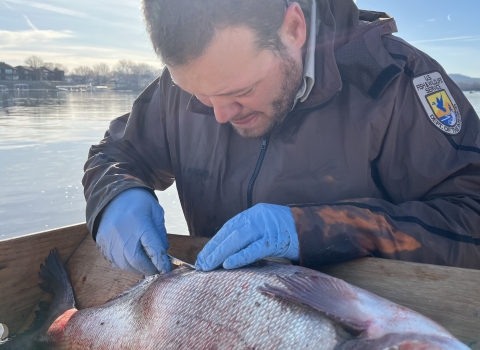About Us
The office provides technical and field expertise to tribal governments in managing their resources, such as assisting in walleye assessments in treaty-ceded territory and restoring lake sturgeon populations of the Red River Basin including the White Earth and Red Lake Nations. One key initiative includes controlling the spread of Aquatic Invasive Species through techniques like eDNA, telemetry, multi-beam sonar,and split-beam hydroacoustics. Habitat biologists work to restore fish passage fish passage
Fish passage is the ability of fish or other aquatic species to move freely throughout their life to find food, reproduce, and complete their natural migration cycles. Millions of barriers to fish passage across the country are fragmenting habitat and leading to species declines. The U.S. Fish and Wildlife Service's National Fish Passage Program is working to reconnect watersheds to benefit both wildlife and people.
Learn more about fish passage at dams in Minnesota, Wisconsin and Iowa and coordinate habitat conservation projects for the Driftless Area Restoration Effort and Fishers and Farmers Partnership for the Upper Mississippi River Basin under the National Fish Habitat Partnership.
What We Do
La Crosse Fish and Wildlife Conservation Office works to:
- Restore native, inter-jurisdictional fishes and aquatic habitats
- Prevent the extinction of federally endangered fish and mussels
- Impede the spread of nonindigenous aquatic nuisance species
- Provide environmental education and outreach
- Attain fish passage fish passage
Fish passage is the ability of fish or other aquatic species to move freely throughout their life to find food, reproduce, and complete their natural migration cycles. Millions of barriers to fish passage across the country are fragmenting habitat and leading to species declines. The U.S. Fish and Wildlife Service's National Fish Passage Program is working to reconnect watersheds to benefit both wildlife and people.
Learn more about fish passage on streams and restore historic fish migrations through the National Fish Passage Program - Work on river and stream restoration, rehabilitation and enhancement projects
- Coordinate two National Fish Habitat Partnerships for the Upper Mississippi River Basin: the Driftless Area Restoration Effort and the Fishers and Farmers Partnership for the Upper Mississippi River Basin
- Fulfill federal trust responsibilities to Native American tribes
Our Organization
The La Crosse Fish and Wildlife Conservation Office is housed within the Midwest Fisheries Center, which also includes the La Crosse Fish Health Center, Whitney Genetics Laboratory and administrative, GIS and outreach staff.
The Midwest Fisheries Center is the region’s Fish Technology Center for U.S. Fish and Wildlife Service. Fish Technology Centers provide leadership in science-based management of trust aquatic resources through applied research and the development of new concepts, strategies and techniques to solve problems in aquatic resource conservation. Established in 2015, the Midwest Fisheries Center’s mission is: “Working in partnership, we provide leadership in science, technology and education for conservation of aquatic ecosystems emphasizing fisheries, aquatic invasive species invasive species
An invasive species is any plant or animal that has spread or been introduced into a new area where they are, or could, cause harm to the environment, economy, or human, animal, or plant health. Their unwelcome presence can destroy ecosystems and cost millions of dollars.
Learn more about invasive species , genetics and aquatic animal health for the benefit of the public”.
Our Species
We work on the detection of invasive species invasive species
An invasive species is any plant or animal that has spread or been introduced into a new area where they are, or could, cause harm to the environment, economy, or human, animal, or plant health. Their unwelcome presence can destroy ecosystems and cost millions of dollars.
Learn more about invasive species including the highly invasive bighead and silver carp and round goby. In addition, the office works on improvement of habitat for the endangered Topeka shiner and other priority fish like brook trout and smallmouth bass, endangered freshwater mussels such as the Higgins eye, and fish passage fish passage
Fish passage is the ability of fish or other aquatic species to move freely throughout their life to find food, reproduce, and complete their natural migration cycles. Millions of barriers to fish passage across the country are fragmenting habitat and leading to species declines. The U.S. Fish and Wildlife Service's National Fish Passage Program is working to reconnect watersheds to benefit both wildlife and people.
Learn more about fish passage for lake sturgeon and other fish and freshwater mussels.
Projects and Research
Understanding seasonal movements and habitat preferences of invasive species is one key to controlling them. If you want to control an invasive species, you must know where they are. To control them efficiently, you need data on their hotspots, where they live during different times of the year, and when they are most active during the day. Acoustic telemetry is one way that biologists are...
It's one of the state's most popular rivers for canoeing, kayaking, tubing, and fishing.
The Upper Iowa River offers the most public land access of all Iowa Rivers.
The Scenic River and Water Trail meanders through limestone bluffs and driftless trout streams and draws visitors from all over the country....
Visit Us
Outreach Programs
The La Crosse Fish and Wildlife Conservation Office is part of the Midwest Fisheries Center and provides all the same outreach programs available at the Center. All of the programs we offer are free of charge. You can either come visit us for a tour or we can accommodate your needs by coming to you or meeting you at a designated location. We serve the La Crosse area and surrounding counties in all nearby states.
Get Involved
The Midwest Fisheries Center offers environmental education activities for community groups and schools. In addition, the center can lend fishing poles to local community groups. Each year, the center co-sponsors several events in the community. There are a variety of volunteer opportunities available in several different areas.
Location and Contact Information
- La Crosse Fish and Wildlife Conservation OfficeView Details555 Lester Avenue Onalaska, WI 54650-8552































